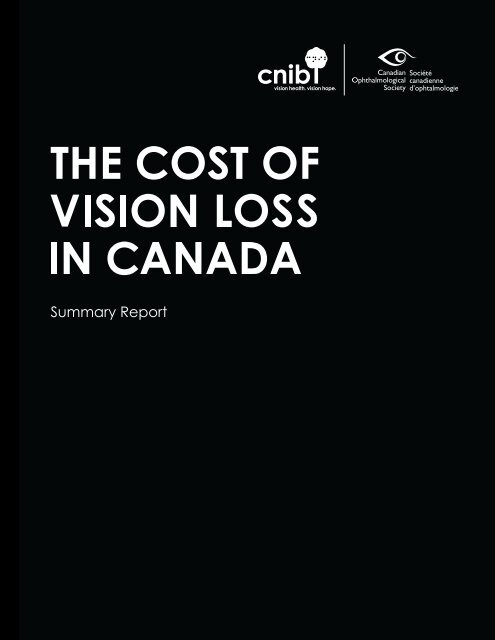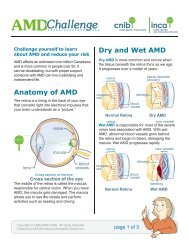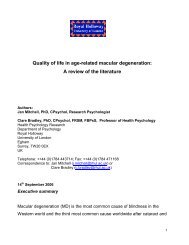The Cost of Vision Loss in Canada: Summary Report - CNIB
The Cost of Vision Loss in Canada: Summary Report - CNIB
The Cost of Vision Loss in Canada: Summary Report - CNIB
- No tags were found...
Create successful ePaper yourself
Turn your PDF publications into a flip-book with our unique Google optimized e-Paper software.
BackgroundIn 2008, <strong>CNIB</strong> and the Canadian Ophthalmological Society commissioned AccessEconomics Pty Limited, a world-lead<strong>in</strong>g <strong>in</strong>dependent economic consult<strong>in</strong>g firm, toconduct a comprehensive study on the cost <strong>of</strong> vision loss <strong>in</strong> <strong>Canada</strong> and its impacton governments, employers, and all Canadians. Specialists <strong>in</strong> model-based healthforecast<strong>in</strong>g and analysis, Access Economics has completed two previous cost <strong>of</strong>vision loss studies, on Australia and the United States.This is the first such research <strong>in</strong> <strong>Canada</strong>. Us<strong>in</strong>g prevalence-based and conservativemethodology, the study builds on exist<strong>in</strong>g, authoritative sources <strong>of</strong> Canadian dataand research. It takes <strong>in</strong>to account <strong>Canada</strong>’s multicultural society and futuredemographic trends. It uses known costs wherever possible, accurately reflect<strong>in</strong>greal Canadian expenditures and government policies. <strong>The</strong> f<strong>in</strong>d<strong>in</strong>gs are extensive,and they are without question the most def<strong>in</strong>itive data now available. This documentprovides a summary <strong>of</strong> the full report, <strong>The</strong> <strong>Cost</strong> <strong>of</strong> <strong>Vision</strong> <strong>Loss</strong> <strong>in</strong> <strong>Canada</strong>, which wasreleased concurrently <strong>in</strong> 2009. In addition, this summary provides supplementarydata, research and analysis to broaden and provide context for the understand<strong>in</strong>g <strong>of</strong>the impact <strong>of</strong> vision loss <strong>in</strong> <strong>Canada</strong>. <strong>CNIB</strong> also has a companion document to thissummary called Pay<strong>in</strong>g the Price: What <strong>Vision</strong> <strong>Loss</strong> <strong>Cost</strong>s Canadians and What WeShould Do About It, which provides a more extensive discussion <strong>of</strong> the results and<strong>CNIB</strong>’s recommendations for a national vision health plan.About <strong>CNIB</strong>:<strong>CNIB</strong> is a nationwide, community-based, registered charity committed to publiceducation, research and the vision health <strong>of</strong> all Canadians. <strong>CNIB</strong> provides theservices and support necessary to enjoy a good quality <strong>of</strong> life while liv<strong>in</strong>g with visionloss. To f<strong>in</strong>d out more, visit www.cnib.ca or call 1-800-563-2642.About the Canadian Ophthalmological Society (COS):COS is the national specialty society represent<strong>in</strong>g Canadian ophthalmologists. Itspurpose is to assure the provision <strong>of</strong> optimal eye care to all Canadians by promot<strong>in</strong>gexcellence <strong>in</strong> ophthalmology and provid<strong>in</strong>g services to support its members <strong>in</strong>practice. For more <strong>in</strong>formation, visit www.eyesite.ca.<strong>The</strong> <strong>Cost</strong> <strong>of</strong> <strong>Vision</strong> <strong>Loss</strong> <strong>in</strong> <strong>Canada</strong>: <strong>Summary</strong> <strong>Report</strong>1
Total <strong>Cost</strong>s<strong>The</strong> real f<strong>in</strong>ancial cost <strong>of</strong> vision loss <strong>in</strong> <strong>Canada</strong> is estimated to be$15.8 billion for 2007 – 1.19% <strong>of</strong> <strong>Canada</strong>’s GDP.• This breaks down to $500 for every Canadian or $19,370 for every Canadian withvision loss <strong>in</strong> 2007.• <strong>The</strong> real f<strong>in</strong>ancial cost is comprised <strong>of</strong> two components: <strong>The</strong> <strong>in</strong>direct costs <strong>of</strong>vision loss are estimated at $7.2 billion, while direct (health-related) costs are$8.6 billion.<strong>The</strong> net cost <strong>of</strong> suffer<strong>in</strong>g (also known as the burden <strong>of</strong> disease)due to vision loss, over and above f<strong>in</strong>ancial costs, is estimated tobe a further $11.7 billion <strong>in</strong> 2007.• For further explanation, see the Direct Health System <strong>Cost</strong>s, Indirect <strong>Cost</strong>s and<strong>Cost</strong> <strong>of</strong> Suffer<strong>in</strong>g (Burden <strong>of</strong> Disease) sections <strong>of</strong> this document.• For cost breakdowns by prov<strong>in</strong>ce and territory, see Appendix A.2<strong>The</strong> <strong>Cost</strong> <strong>of</strong> <strong>Vision</strong> <strong>Loss</strong> <strong>in</strong> <strong>Canada</strong>: <strong>Summary</strong> <strong>Report</strong>
Who Pays the <strong>Cost</strong>s?All <strong>of</strong> us pay the costs <strong>of</strong> vision loss.• <strong>The</strong> f<strong>in</strong>ancial costs break down as follows: <strong>in</strong>dividuals with vision loss ($3.5billion), family/friends ($474 million), federal government ($2.4 billion),prov<strong>in</strong>cial/territorial governments ($6.3 billion), employers ($141 million) andsociety/other ($3.0 billion).• <strong>The</strong> largest f<strong>in</strong>ancial costs come out <strong>of</strong> taxpayers’ pockets: federal and prov<strong>in</strong>cialgovernments bear 55.3% <strong>of</strong> the costs and “all <strong>of</strong> society” bears a further 18.7%.• Federal government costs are associated with taxation revenues foregone and thecost <strong>of</strong> adm<strong>in</strong>ister<strong>in</strong>g programs for people with vision loss. <strong>The</strong> majority <strong>of</strong>prov<strong>in</strong>cial costs are health system expenditures.• Individuals with vision loss <strong>in</strong>cur costs associated with lost productivity, healthcare, and devices and specialized equipment. <strong>The</strong> major cost for family/friendscomes from lost earn<strong>in</strong>gs associated with care giv<strong>in</strong>g. Employers’ largest costcomes from foregone productivity. <strong>Cost</strong>s for “all <strong>of</strong> society” come from healthsystem costs and adm<strong>in</strong>istration.• When the burden <strong>of</strong> disease is <strong>in</strong>cluded, the majority <strong>of</strong> costs (55.2%) are borneby <strong>in</strong>dividuals with vision loss.• For a full breakdown by type <strong>of</strong> cost and bearer, see Appendix B.<strong>The</strong> <strong>Cost</strong> <strong>of</strong> <strong>Vision</strong> <strong>Loss</strong> <strong>in</strong> <strong>Canada</strong>: <strong>Summary</strong> <strong>Report</strong>3
Comparison to Other Diseases<strong>The</strong> cost <strong>of</strong> vision loss is an enormous burden <strong>in</strong> <strong>Canada</strong> – farahead <strong>of</strong> most other diseases.• In compar<strong>in</strong>g results from this study with Public Health Agency <strong>of</strong> <strong>Canada</strong> data,vision loss accounts for a large proportion – approximately 8% – <strong>of</strong> the economicburden <strong>of</strong> illness <strong>in</strong> <strong>Canada</strong>.<strong>Vision</strong> loss has the highest health care costs (direct costs) <strong>of</strong>any disease category <strong>in</strong> <strong>Canada</strong> – cost<strong>in</strong>g Canadians much morethan diabetes, all cancers or cardiovascular disease.• For a full comparison, see Appendix C.4<strong>The</strong> <strong>Cost</strong> <strong>of</strong> <strong>Vision</strong> <strong>Loss</strong> <strong>in</strong> <strong>Canada</strong>: <strong>Summary</strong> <strong>Report</strong>
Comparison to Other DiseasesWhen compared to other diseases, vision loss is also a hugeburden <strong>in</strong> terms <strong>of</strong> overall f<strong>in</strong>ancial expenditure, largely due tothe high cost <strong>of</strong> lost productivity to the Canadian economy.• In total f<strong>in</strong>ancial costs (direct and <strong>in</strong>direct), vision loss ranks fourth compared toall other disease categories, ahead <strong>of</strong> diabetes, respiratory diseases and mentaldisorders.• For a full comparison, see Appendix C.<strong>The</strong> <strong>Cost</strong> <strong>of</strong> <strong>Vision</strong> <strong>Loss</strong> <strong>in</strong> <strong>Canada</strong>: <strong>Summary</strong> <strong>Report</strong>5
Direct Health System <strong>Cost</strong>s<strong>The</strong> direct costs associated with vision health are exceptionallylarge – $8.6 billion <strong>in</strong> 2007.• <strong>The</strong> largest health cost (40% <strong>of</strong> the total) fell under vision care, which coversoptometrists, ophthalmologists, opticians and corrective lenses. <strong>The</strong> majority <strong>of</strong>this cost is publicly funded, usually by prov<strong>in</strong>cial and territorial governments.• Other major costs <strong>in</strong>clude hospital care for people with vision loss (20%) andother expenditures (17%), which refers to public health, adm<strong>in</strong>istration, capitalcosts and expenditures not classified elsewhere.• Physician’s services (10%) cover fee-for-service payments by prov<strong>in</strong>cial andterritorial medical <strong>in</strong>surance plans for procedures such as eye exams, treatmentsand surgeries.• Other <strong>in</strong>stitutions (5%) refers to expenditures for people liv<strong>in</strong>g <strong>in</strong> facilities such asnurs<strong>in</strong>g homes as a result <strong>of</strong> vision loss.In the last few decades, expenditure on health care <strong>in</strong> <strong>Canada</strong>has been grow<strong>in</strong>g rapidly – considerably faster than GDP.However, expenditure on vision care has risen even faster,grow<strong>in</strong>g from 1.8% <strong>of</strong> total health expenditure <strong>in</strong> 1975 to2.2% <strong>in</strong> 2007.6<strong>The</strong> <strong>Cost</strong> <strong>of</strong> <strong>Vision</strong> <strong>Loss</strong> <strong>in</strong> <strong>Canada</strong>: <strong>Summary</strong> <strong>Report</strong>
Indirect <strong>Cost</strong>sJust as important as the direct costs <strong>of</strong> vision loss are the<strong>in</strong>direct costs, which are nearly as high. Indirect costs add$7.2 billion to the overall cost <strong>of</strong> vision loss each year.• <strong>The</strong> largest <strong>in</strong>direct cost (62% <strong>of</strong> the total) is associated with productivity – lostearn<strong>in</strong>gs for people with vision loss, which is estimated to cost the Canadianeconomy nearly $4.4 billion annually. <strong>The</strong> employment rate among work<strong>in</strong>g-agepeople with vision loss is only 32%.• Transfer costs (24%) – also known as deadweight losses – refers toadm<strong>in</strong>istration and the costs associated with rais<strong>in</strong>g additional tax revenues tocover programs such as <strong>in</strong>come tax reductions and disability support programs.— <strong>The</strong> payments themselves are not <strong>in</strong>cluded <strong>in</strong> totals because they aretransfers, not real economic costs.• Care and rehabilitation (10%) refers to the lost productivity (earn<strong>in</strong>gs) associatedwith family and friends who act as caregivers for people with vision loss. It alsorefers to the services provided by vision rehabilitation agencies and specializedlibrary services.• Other <strong>in</strong>direct costs (4%) refers to the wide variety <strong>of</strong> devices, homemodifications, and specialized equipment required by people with vision loss toma<strong>in</strong>ta<strong>in</strong> <strong>in</strong>dependence and enhance quality <strong>of</strong> life.<strong>The</strong> <strong>Cost</strong> <strong>of</strong> <strong>Vision</strong> <strong>Loss</strong> <strong>in</strong> <strong>Canada</strong>: <strong>Summary</strong> <strong>Report</strong>7
<strong>Cost</strong> <strong>of</strong> Suffer<strong>in</strong>g (Burden <strong>of</strong> Disease)<strong>Vision</strong> loss imposes a substantial amount <strong>of</strong> suffer<strong>in</strong>g onCanadians from lost quality <strong>of</strong> life. This adds a further $11.7billion to the bill for <strong>Canada</strong> – the largest <strong>of</strong> all costs attributedto vision loss.• Although burden <strong>of</strong> disease is a non-f<strong>in</strong>ancial estimate, it is an important measure<strong>of</strong> the human toll caused by vision loss. It also provides a benchmark for publicpolicymakers to compare different diseases and to determ<strong>in</strong>e the costeffectiveness<strong>of</strong> <strong>in</strong>terventions.• <strong>The</strong> burden <strong>of</strong> disease calculation uses disability adjusted life years (DALY), whereone DALY represents the loss <strong>of</strong> the equivalent <strong>of</strong> one full year <strong>of</strong> health. <strong>The</strong>DALY measure takes <strong>in</strong>to account both disability and premature death associatedwith a disease.Canadians with vision loss were deprived <strong>of</strong> the equivalent <strong>of</strong>77,358 years <strong>of</strong> healthy life due to disability and prematuredeath <strong>in</strong> 2007.• Us<strong>in</strong>g this number multiplied by the value <strong>of</strong> a statistical life year and thenadjust<strong>in</strong>g for all personal costs accounted for elsewhere (such as productionlosses and transfers to people with vision loss) resulted <strong>in</strong> a burden <strong>of</strong> diseasevalue <strong>of</strong> $11.7 billion.<strong>Vision</strong> loss prevents healthy and <strong>in</strong>dependent liv<strong>in</strong>g – and age<strong>in</strong>g.• Compared to people who are sighted, people with vision loss experience:o Two to five times as much difficulty with daily liv<strong>in</strong>go Three times as much cl<strong>in</strong>ical depressiono Twice as much social dependenceo A greater number <strong>of</strong> medication errorso Twice the risk <strong>of</strong> falls and premature deatho Four times the risk <strong>of</strong> serious hip fractureso Premature admission to nurs<strong>in</strong>g homes – three years earlier on averageCanadians place a high value on their vision and fear vision lossmore than most other diseases.• <strong>The</strong> socio-economic impacts <strong>of</strong> vision loss <strong>in</strong>clude high unemployment rates,social isolation, poverty, a greater use <strong>of</strong> health and social services and emotionaldistress.• Accord<strong>in</strong>g to a 2005 report, half <strong>of</strong> all adults with vision loss report gross annual<strong>in</strong>comes <strong>of</strong> $20,000 or less, regardless <strong>of</strong> marital or family status.• <strong>The</strong>se impacts can be reduced with employment accommodation and visionrehabilitation and support services.8<strong>The</strong> <strong>Cost</strong> <strong>of</strong> <strong>Vision</strong> <strong>Loss</strong> <strong>in</strong> <strong>Canada</strong>: <strong>Summary</strong> <strong>Report</strong>
Pr<strong>of</strong>ile <strong>of</strong> <strong>Vision</strong> <strong>Loss</strong><strong>Vision</strong> loss is widespread – and <strong>of</strong>ten overlooked <strong>in</strong> <strong>Canada</strong>.• In <strong>Canada</strong>, vision loss is usually def<strong>in</strong>ed as a visual acuity <strong>of</strong> less than 20/40 <strong>in</strong>the better-see<strong>in</strong>g eye, even with corrective lenses. Bl<strong>in</strong>dness (a subset <strong>of</strong> visionloss) is def<strong>in</strong>ed as 20/200 or worse <strong>in</strong> the better-see<strong>in</strong>g eye, even with correctivelenses, or a visual field <strong>of</strong> less than 20 degrees <strong>in</strong> the horizontal plane.Every 12 m<strong>in</strong>utes <strong>in</strong> <strong>Canada</strong>, someone develops vision loss.• More than 817,000 Canadians are currently liv<strong>in</strong>g with vision loss. In addition,3.43 million other Canadians live with some form <strong>of</strong> AMD, diabetic ret<strong>in</strong>opathy,glaucoma or cataracts. <strong>The</strong>y may not have vision loss yet, but if left untreated,most <strong>of</strong> these people are at high risk.• <strong>Vision</strong> loss affects women slightly more than men, reflect<strong>in</strong>g greater longevity <strong>in</strong>females.• After age 40, the number <strong>of</strong> cases <strong>of</strong> vision loss doubles approximately everydecade. At 75, it triples.<strong>The</strong> <strong>Cost</strong> <strong>of</strong> <strong>Vision</strong> <strong>Loss</strong> <strong>in</strong> <strong>Canada</strong>: <strong>Summary</strong> <strong>Report</strong>9
Causes <strong>of</strong> <strong>Vision</strong> <strong>Loss</strong>Most vision loss <strong>in</strong> <strong>Canada</strong> is caused by five eye conditions.o Age-related macular degeneration (AMD)o Cataracto Diabetic ret<strong>in</strong>opathyo Glaucomao Refractive error• For a breakdown <strong>of</strong> the costs <strong>of</strong> vision loss by eye condition, see Appendix D.AMDAMD is <strong>in</strong>curable and the lead<strong>in</strong>g eye disease caus<strong>in</strong>g vision loss <strong>in</strong> <strong>Canada</strong>. Itusually affects people over 50. One million Canadians have some form <strong>of</strong> AMD. Ithas a strong genetic l<strong>in</strong>k, and people who smoke have up to four times the risk <strong>of</strong>develop<strong>in</strong>g it.A specific high-dose vitam<strong>in</strong> formulation is known to reduce the risk <strong>of</strong> diseaseprogression for some people with dry AMD. <strong>The</strong>re are treatments available for wetAMD that can stop further vision loss and restore lost vision <strong>in</strong> some cases.10<strong>The</strong> <strong>Cost</strong> <strong>of</strong> <strong>Vision</strong> <strong>Loss</strong> <strong>in</strong> <strong>Canada</strong>: <strong>Summary</strong> <strong>Report</strong>
Causes <strong>of</strong> <strong>Vision</strong> <strong>Loss</strong>GlaucomaGlaucoma is the second most common cause <strong>of</strong> vision loss <strong>in</strong> Canadians over 65.About 250,000 Canadians have some form <strong>of</strong> glaucoma, but only half <strong>of</strong> them areaware <strong>of</strong> it. Early detection and strict compliance to treatment (usually byprescription eye drops) can help to control the disease and protect vision.Refractive Error (RE) / OtherRefractive error is the most frequent yet most easily correctible source <strong>of</strong> vision loss<strong>in</strong> <strong>Canada</strong>. It occurs when a person’s vision is reduced because they need correctivelenses and do not have them or their current lenses need to be changed to givethem clear vision. Less common conditions such as corneal disease and ret<strong>in</strong>itispigmentosa account for the rema<strong>in</strong><strong>in</strong>g vision loss <strong>in</strong> this category.12<strong>The</strong> <strong>Cost</strong> <strong>of</strong> <strong>Vision</strong> <strong>Loss</strong> <strong>in</strong> <strong>Canada</strong>: <strong>Summary</strong> <strong>Report</strong>
<strong>Vision</strong> <strong>Loss</strong> and Ethnicity<strong>Vision</strong> loss prevalence can vary greatly depend<strong>in</strong>g on gender,age and ethnicity.Generally, the study based projections on two group<strong>in</strong>gs: Caucasians and visiblem<strong>in</strong>orities. Further overall breakdowns based on ethnicity were not possible givendeficiencies <strong>in</strong> large-scale Canadian studies. However, <strong>in</strong> some cases data wassupplemented with smaller studies on specific m<strong>in</strong>ority populations.Some f<strong>in</strong>d<strong>in</strong>gs based on ethnicity:• People who are Caucasian have somewhat higher rates <strong>of</strong> overall vision loss <strong>in</strong><strong>Canada</strong> compared to visible m<strong>in</strong>orities.• <strong>The</strong>re are many differences for specific eye conditions. For example:o Older (60+) visible m<strong>in</strong>ority women have the highest rates <strong>of</strong> cataract whileelderly visible m<strong>in</strong>ority males have the lowest rates.o Men from visible m<strong>in</strong>ority populations have high rates <strong>of</strong> glaucoma.o Caucasians are more likely to have vision loss from AMD than African-Canadians, while the reverse is true for refractive error.o Ch<strong>in</strong>ese-Canadians have double the rate <strong>of</strong> AMD compared to Caucasians andmay have twice the rate <strong>of</strong> diabetic ret<strong>in</strong>opathy. Ch<strong>in</strong>ese-Canadian children aremore likely to experience nearsightedness than children who are Caucasian.o Aborig<strong>in</strong>al Canadians have higher rates <strong>of</strong> diabetic ret<strong>in</strong>opathy. Inuitpopulations have much higher rates <strong>of</strong> primary open-angle glaucoma.• <strong>The</strong>se variations reflect differences <strong>in</strong> treatment access and genetic factors.• Despite the fact that the visible m<strong>in</strong>ority share <strong>of</strong> <strong>Canada</strong>’s population is rapidly<strong>in</strong>creas<strong>in</strong>g, this group’s share <strong>of</strong> vision loss may not rise significantly <strong>in</strong> the next25 years, largely due to a younger age pr<strong>of</strong>ile as a result <strong>of</strong> immigration.However, this may be <strong>of</strong>fset by <strong>in</strong>creases <strong>in</strong> diabetic ret<strong>in</strong>opathy, which are alsoanticipated as a result <strong>of</strong> immigration.<strong>The</strong> <strong>Cost</strong> <strong>of</strong> <strong>Vision</strong> <strong>Loss</strong> <strong>in</strong> <strong>Canada</strong>: <strong>Summary</strong> <strong>Report</strong>13
<strong>The</strong> Future <strong>of</strong> <strong>Vision</strong> <strong>Loss</strong>Unless we do someth<strong>in</strong>g about it, the costs <strong>of</strong> vision loss areonly go<strong>in</strong>g to rise rapidly <strong>in</strong> future, mak<strong>in</strong>g our health caresystem even more overburdened and tak<strong>in</strong>g a greater toll onCanadians.• In the next 25 years, the number <strong>of</strong> Canadians with vision loss is projected todouble.• <strong>The</strong> number affected will top one million <strong>in</strong> the next five years and cont<strong>in</strong>ueescalat<strong>in</strong>g.Based on current projections, the f<strong>in</strong>ancial expendituresassociated with vision loss would cost Canadians $30.3 billion by2032 (<strong>in</strong> 2007 dollars).• For some eye diseases, prevalence is <strong>in</strong>creas<strong>in</strong>g faster than population growthacross all age groups.• However, most <strong>of</strong> the projected <strong>in</strong>crease is due to <strong>Canada</strong>’s rapidly ag<strong>in</strong>gpopulation (<strong>of</strong>ten called the demographic tsunami) comb<strong>in</strong>ed with the fact that<strong>Canada</strong>’s major eye conditions are age-related.• In 2006, one <strong>in</strong> seven Canadians was 65 years or older. By 2032, it will be one <strong>in</strong>four.14<strong>The</strong> <strong>Cost</strong> <strong>of</strong> <strong>Vision</strong> <strong>Loss</strong> <strong>in</strong> <strong>Canada</strong>: <strong>Summary</strong> <strong>Report</strong>
What We Can Do<strong>Canada</strong> needs to wake up when it comes to the vision healthcrisis. <strong>Vision</strong> loss places an enormous burden on society. <strong>The</strong>problem is widespread and <strong>in</strong>creas<strong>in</strong>g rapidly.• Three quarters <strong>of</strong> vision loss is avoidable – it can be prevented or treated.• With more research dollars allocated to vision health, we could become muchcloser to cur<strong>in</strong>g eye disease.• By elevat<strong>in</strong>g vision health as a public health issue (on the same level as smok<strong>in</strong>gcessation or diabetes), Canadians could become much better <strong>in</strong>formed aboutvision loss and take significant steps to reduce their risk.• <strong>The</strong> f<strong>in</strong>ancial and human cost <strong>of</strong> unavoidable eye disease could be greatly reducedby provid<strong>in</strong>g cost-effective supports such as employment accommodation andrehabilitation services.<strong>Vision</strong> care has a variety <strong>of</strong> successful, evidence-based, and costeffective <strong>in</strong>terventions.• In <strong>Canada</strong>, an <strong>in</strong>tervention is considered cost-effective if it costs less than$40,000 per quality <strong>of</strong> life year (QALY).• Cataract surgery costs $2,100 per QALY for the first eye and $2,727 for thesecond eye.• Screen<strong>in</strong>g and treatment <strong>of</strong> diabetic ret<strong>in</strong>opathy costs $3,190 per QALY. Screen<strong>in</strong>g<strong>in</strong> remote First Nations communities costs $11,000 per QALY.• Canadian research shows $13 million can be saved over five years for every100,000 patients with dry AMD who are treated with high-dose vitam<strong>in</strong>s.• In comparison, consider the follow<strong>in</strong>g cost-effectiveness values for other health<strong>in</strong>terventions:o Aspir<strong>in</strong> for coronary disease: $11,000 per QALY.o HIV/AIDS early anti-retroviral therapy: $14,000 - $28,000 per QALY.o Liver transplantation: $51,000 per QALY.o Breast cancer treatment – breast conservation/radiation or mastectomy:$82,000 per QALY.<strong>The</strong> <strong>Cost</strong> <strong>of</strong> <strong>Vision</strong> <strong>Loss</strong> <strong>in</strong> <strong>Canada</strong>: <strong>Summary</strong> <strong>Report</strong>15
A Call to Action<strong>Canada</strong> urgently needs to develop a national vision plan to dealwith the vision loss crisis.• Canadians will never be able to reduce the overwhelm<strong>in</strong>g human and f<strong>in</strong>ancialcost <strong>of</strong> vision loss without an overall strategy to get us there.• In 2003, the Canadian government made a commitment to the World HealthOrganization (WHO) to develop a national vision plan by 2005 and beg<strong>in</strong>implement<strong>in</strong>g it by 2007.• Many other nations made the same commitment and have begun develop<strong>in</strong>gvision plans. Countries such as the United K<strong>in</strong>gdom and Australia are already wellon their way with implementation.• S<strong>in</strong>ce 2003, more than 262,800 Canadians have developed significant vision loss,and <strong>Canada</strong> still has no vision health plan to deal with the crisis.• Every year we wait costs us $15.8 billion.• Every year we wait, another 43,800 Canadians lose their vision.16<strong>The</strong> <strong>Cost</strong> <strong>of</strong> <strong>Vision</strong> <strong>Loss</strong> <strong>in</strong> <strong>Canada</strong>: <strong>Summary</strong> <strong>Report</strong>
Appendix A<strong>Cost</strong>s <strong>of</strong> <strong>Vision</strong> <strong>Loss</strong> by Prov<strong>in</strong>ce and Territory(costs <strong>in</strong> millions <strong>of</strong> dollars)% <strong>of</strong> Cdns.with <strong>Vision</strong> Direct Indirect Total Burden <strong>of</strong> TOTAL<strong>Loss</strong> 1 <strong>Cost</strong>s <strong>Cost</strong>s F<strong>in</strong>ancial Disease COVL 2<strong>Canada</strong> 100.00 8,600.0 7,205.0 15,800.0 11,700.0 27,505.0Nfld 1.70 146.2 122.5 268.6 198.9 467.6PEI 0.50 43.0 36.0 79.0 58.5 137.5N.S. 3.60 309.6 259.4 568.8 421.2 990.2N.B. 2.70 258.0 216.2 474.0 351.0 825.2Que 16.80 1,444.8 1,210.4 2,654.4 1,965.6 4,620.8Ont 44.50 3,827.0 3,206.2 7,031.0 5,206.5 12,239.7Man 4.40 378.4 317.0 695.2 514.8 1,210.2Sask 2.90 172.0 144.1 316.0 234.0 550.1Alta 9.50 817.0 684.5 1,501.0 1,111.5 2,613.0B.C. 13.30 1,143.8 958.3 2,101.4 1,556.1 3,658.2Yukon 0.10 8.3 7.0 15.3 11.3 26.7NWT 0.08 6.9 5.8 12.6 9.4 22.0Nunavut 0.04 3.3 2.7 6.0 4.4 10.51Prevalence data from the Participation and Activity Limitation Survey (PALS),2006, Statistics <strong>Canada</strong>.2It should be noted that Total COVL <strong>in</strong>cludes both f<strong>in</strong>ancial and non-f<strong>in</strong>ancialestimates. It is not a f<strong>in</strong>ancial cost estimate, but still a useful benchmark and ameasure that takes account <strong>of</strong> the human cost <strong>of</strong> vision loss.<strong>The</strong> <strong>Cost</strong> <strong>of</strong> <strong>Vision</strong> <strong>Loss</strong> <strong>in</strong> <strong>Canada</strong>: <strong>Summary</strong> <strong>Report</strong>17
Appendix B<strong>Cost</strong>s <strong>of</strong> <strong>Vision</strong> <strong>Loss</strong> by Type <strong>of</strong> <strong>Cost</strong> and Bearer(costs <strong>in</strong> millions <strong>of</strong> dollars)Individuals Family Federal Prov<strong>in</strong>cial Employers Society TotalFriends Government Governments OthersTotal cost ($ millions)Burden <strong>of</strong> disease 11,710 0 0 0 0 0 11,710.4Health system costs 1,499 0 388 5,607 0 1,081 8,637.9Lost productivity 2,847 0 886 619 80 0 4,431.4Care and rehabilitation 0 413 218 0 0 62 692.8Other <strong>in</strong>direct costs 61 62 0 61 61 61 304.9Adm<strong>in</strong>istrative costs 0 0 0 0 0 1,757 1,757.0Transfer costs -917 0 917 0 0 0 0Total f<strong>in</strong>ancial costs 3,490 474 2,409 6,350 141 2,960 15,824Total costs <strong>in</strong>clud<strong>in</strong>gburden <strong>of</strong> disease 15,200 474 2,409 6,350 141 27,534<strong>Cost</strong> per person with vision loss ($)Burden <strong>of</strong> disease 14,334 0 0 0 0 0 14,334Health system costs 1,835 0 475 6,941 0 1,323 10,573Lost productivity 3,458 0 1,084 757 98 0 5,424Care and rehabilitation 0 505 267 0 0 76 848Other <strong>in</strong>direct costs 74 76 0 74 74 74 373Adm<strong>in</strong>istrative costs 0 0 0 0 0 2,151 2,151Transfer costs -1,122 0 1,122 0 0 0 0Total f<strong>in</strong>ancial costs 4,272 581 2,948 7,773 172 3,624 19,370Total costs <strong>in</strong>clud<strong>in</strong>gburden <strong>of</strong> disease 18,606 581 2,948 7,773 172 3,624 33,704In per capita terms, this amounts to a f<strong>in</strong>ancial cost <strong>of</strong> $19,370 per person with vision loss per annum. Includ<strong>in</strong>gthe value <strong>of</strong> lost wellbe<strong>in</strong>g, the cost is $33,704 per person per annum.18<strong>The</strong> <strong>Cost</strong> <strong>of</strong> <strong>Vision</strong> <strong>Loss</strong> <strong>in</strong> <strong>Canada</strong>: <strong>Summary</strong> <strong>Report</strong>
Appendix C<strong>Cost</strong>s <strong>of</strong> <strong>Vision</strong> <strong>Loss</strong> Compared toOther Disease Categories <strong>in</strong> <strong>Canada</strong> 1(costs <strong>in</strong> millions <strong>of</strong> dollars)Diagnostic Direct Indirect TotalCategory 2 <strong>Cost</strong>s Rank <strong>Cost</strong>s Rank F<strong>in</strong>ancial RankBlood diseases 260.60 19 299.30 19 560.00 20Per<strong>in</strong>atal conditions 373.50 18 364.40 18 737.90 19Birth defects 214.70 20 647.60 16 862.20 18Sk<strong>in</strong> and relateddiseases 1,800.60 14 230.00 20 2,030.60 17Pregnancy 1,584.20 15 477.30 17 2,061.50 16Infectious andparasitic 1,110.20 16 1,480.60 13 2,590.80 15Endocr<strong>in</strong>e andrelated diseases(diabetes) 1,935.40 13 2,295.70 12 4,231.10 14Genitour<strong>in</strong>ary 3,172.10 10 1,119.30 14 4,291.50 13Others 3,934.50 7 835.20 15 4,769.70 12Well-patient care 3,203.80 9 2,900.50 10 6,104.50 11Ill def<strong>in</strong>edconditions 2,149.90 12 4,783.90 8 6,933.80 10Nervous systemand sense organ 3 934.50 17 6,042.20 7 6,976.70 9Digestive diseases 4,323.50 4 2,826.30 11 7,149.90 8Mental disorders 5,716.80 3 3,896.80 9 9,613.60 7Respiratorydiseases 4,227.50 5 6,191.70 6 10,419.20 6Injuries 3,938.50 6 11,617.60 4 15,556.10 5VISION LOSS 8,637.90 1 7,186.00 5 15,824.00 4Cancer 3,007.40 11 14,360.40 2 17,367.80 3Musculoskeletaldiseases 3,234.50 8 16,772.20 1 20,006.80 2Cardiovasculardiseases 8,327.10 2 14,234.30 3 22,561.40 1Unattributable 4 46,574.10 n/a 161.10 n/a 46,735.30 n/a<strong>The</strong> <strong>Cost</strong> <strong>of</strong> <strong>Vision</strong> <strong>Loss</strong> <strong>in</strong> <strong>Canada</strong>: <strong>Summary</strong> <strong>Report</strong>19
1Table has been adapted from Buhrmann et al, Foundations for a Canadian <strong>Vision</strong>Health Strategy: Towards Prevent<strong>in</strong>g Avoidable Bl<strong>in</strong>dness and Promot<strong>in</strong>g <strong>Vision</strong>Health, National Coalition for <strong>Vision</strong> Health, January 2007, Appendix B, Table B1.4,which itself is adapted from Economic Burden <strong>of</strong> Illness <strong>in</strong> <strong>Canada</strong> (EBIC), 1998,Public Health Agency <strong>of</strong> <strong>Canada</strong> 2002; available at: http://www.phacaspc.gc.ca/publicat/ebic-femc98/<strong>in</strong>dex.html.Accessed May 1, 2009. Although themethodology used <strong>in</strong> the <strong>Cost</strong> <strong>of</strong> <strong>Vision</strong> <strong>Loss</strong> study is not identical to that used <strong>in</strong>EBIC, it is very similar. All costs have been adjusted for <strong>in</strong>flation to reflect 2007Canadian dollars.2With<strong>in</strong> EBIC’s diagnostic categories, which are based on the InternationalClassification <strong>of</strong> Disease, N<strong>in</strong>th Revision (ICD-9) system, “Endocr<strong>in</strong>e and relateddiseases” refers to diabetes. “Respiratory diseases” refers to acute respiratory<strong>in</strong>fections, pneumonia and <strong>in</strong>fluenza, COPD, and asthma. “Musculoskeletal diseases”refers to arthritis and osteoporosis. For further explanation <strong>of</strong> categories, seeEconomic Burden <strong>of</strong> Illness <strong>in</strong> <strong>Canada</strong> (EBIC), 1998, Appendix 1.3With<strong>in</strong> the “Nervous system and sense organ disease” category, EBIC <strong>in</strong>cludesAlzheimer’s disease, Park<strong>in</strong>son’s disease, glaucoma, disorders <strong>of</strong> conjunctiva, andear <strong>in</strong>fections. However for the purposes <strong>of</strong> this analysis, costs with<strong>in</strong> EBIC’s reportthat are known to be related to vision loss have been adjusted to 2007 dollars andthen subtracted from costs associated with the “Nervous system and sense organdisease” category so that they are not counted twice.4EBIC lists “unattributable” costs as any data that cannot be allocated by ICD-9code. Although this category <strong>of</strong> costs is large, it has not been <strong>in</strong>cluded <strong>in</strong> therank<strong>in</strong>gs s<strong>in</strong>ce it does not refer to any one category <strong>of</strong> disease.20<strong>The</strong> <strong>Cost</strong> <strong>of</strong> <strong>Vision</strong> <strong>Loss</strong> <strong>in</strong> <strong>Canada</strong>: <strong>Summary</strong> <strong>Report</strong>
Appendix D<strong>Cost</strong>s <strong>of</strong> <strong>Vision</strong> <strong>Loss</strong> by Ma<strong>in</strong> Causes <strong>in</strong> <strong>Canada</strong>(costs <strong>in</strong> millions <strong>of</strong> dollars)Type <strong>of</strong> <strong>Cost</strong> AMD Diabetic Cataract Glaucoma RefractiveRet<strong>in</strong>opathyError/Other 4Hospitals 195.2 44.7 104.5 119.2 755.8Physicians’Services 112.9 25.8 60.4 69.0 437.3Pharmaceuticals 73.4 16.8 39.3 44.9 284.4<strong>Vision</strong> Care 454.0 103.9 243.0 277.3 1758.0Research 4.9 1.1 2.6 3.0 18.9OtherInstitutions 58.0 13.3 31.0 35.4 224.5OtherExpenditures 226.8 51.9 121.4 138.5 878.2Total Direct<strong>Cost</strong>s 1 1,125.2 257.5 602.2 687.3 4357.1Lost Productivity 484.9 162.6 727.2 135.5 2929.8Transfer <strong>Cost</strong>s 192.3 64.5 288.3 53.7 1161.6Care andRehabilitation 75.8 25.4 113.7 21.2 458.0Other Indirect<strong>Cost</strong>s 33.4 11.2 50.0 9.3 201.6Total Indirect<strong>Cost</strong>s 2 786.3 263.6 1,179.2 219.7 4751.0Total F<strong>in</strong>ancial 1,911.5 521.1 1,781.4 907.0 9108.1Burden <strong>of</strong>Disease 3 1,275.3 432.9 1,918.8 362.7 7722.0Total COVL 5 3,186.8 954.0 3,700.2 1,269.7 16,830.1<strong>The</strong> <strong>Cost</strong> <strong>of</strong> <strong>Vision</strong> <strong>Loss</strong> <strong>in</strong> <strong>Canada</strong>: <strong>Summary</strong> <strong>Report</strong>21
1Direct costs were calculated by tak<strong>in</strong>g the bottom-up number for each disease (p.68 <strong>of</strong> the <strong>Cost</strong> <strong>of</strong> <strong>Vision</strong> <strong>Loss</strong> report) and multiply<strong>in</strong>g by the 25.2% mark-up used t<strong>of</strong>actor <strong>in</strong> capital expenditure, research, public health and other unallocated healthexpenditure. <strong>The</strong> totals for each eye condition were then used to calculate apercentage <strong>of</strong> direct costs for each condition. <strong>The</strong>se percentages were applied to theoverall number for direct health expenditures (calculated by the top-down method).2Indirect costs were calculated by tak<strong>in</strong>g the overall <strong>in</strong>direct cost <strong>of</strong> vision loss($7.2 billion), divid<strong>in</strong>g it by the total number <strong>of</strong> Canadians with vision loss(817,171) and multiply<strong>in</strong>g it by the number <strong>of</strong> Canadians with each eye condition(taken from p. ii <strong>of</strong> the <strong>Cost</strong> <strong>of</strong> <strong>Vision</strong> <strong>Loss</strong> report).3Burden <strong>of</strong> disease costs were calculated by tak<strong>in</strong>g the overall burden <strong>of</strong> diseasecost ($11.7 billion) and multiply<strong>in</strong>g it by the percentage <strong>of</strong> total vision loss that eacheye condition represented (p. ii <strong>of</strong> the <strong>Cost</strong> <strong>of</strong> <strong>Vision</strong> <strong>Loss</strong> report).4It should be noted that add<strong>in</strong>g up the cost <strong>of</strong> vision loss for each eye conditionproduces a number that is not 100% <strong>of</strong> the cost <strong>of</strong> vision loss found <strong>in</strong> the report.This is because the direct cost calculation for refractive error does not <strong>in</strong>clude“other” eye diseases (s<strong>in</strong>ce this <strong>in</strong>formation was not available), however, “other” eyediseases are <strong>in</strong>cluded <strong>in</strong> the refractive error category <strong>in</strong> terms <strong>of</strong> the <strong>in</strong>direct andburden <strong>of</strong> disease calculations and the overall cost <strong>of</strong> vision loss.5It should be noted that Total COVL <strong>in</strong>cludes both f<strong>in</strong>ancial and non-f<strong>in</strong>ancialestimates. It is not a f<strong>in</strong>ancial cost estimate, but still a useful benchmark and ameasure that takes account <strong>of</strong> the human cost <strong>of</strong> vision loss.22<strong>The</strong> <strong>Cost</strong> <strong>of</strong> <strong>Vision</strong> <strong>Loss</strong> <strong>in</strong> <strong>Canada</strong>: <strong>Summary</strong> <strong>Report</strong>
Appendix EBibliography: Sources Consulted for this <strong>Report</strong>Buhrmann, Ralph, et al, Foundations for a <strong>Vision</strong> Health Strategy: TowardsPrevent<strong>in</strong>g Avoidable Bl<strong>in</strong>dness and Promot<strong>in</strong>g <strong>Vision</strong> Health, National Coalition for<strong>Vision</strong> Health, 2007; available atwww.visionhealth.ca/projects/documents/Foundations-For-A-Canadian-<strong>Vision</strong>-Health-Strategy.pdf.Canadian Community Health Survey. Statistics <strong>Canada</strong>. 2003.<strong>The</strong> <strong>Cost</strong> <strong>of</strong> <strong>Vision</strong> <strong>Loss</strong> <strong>in</strong> <strong>Canada</strong>: A <strong>Report</strong> by Access Economics Pty Limited for<strong>CNIB</strong> and COS, June 2009; available at www.cnib.ca.<strong>CNIB</strong>, An Unequal Play<strong>in</strong>g Field: <strong>Report</strong> on the Needs <strong>of</strong> People Who Are Bl<strong>in</strong>d orVisually Impaired Liv<strong>in</strong>g <strong>in</strong> <strong>Canada</strong>, A report for Human Resources Development<strong>Canada</strong> - Office for Disability Issues, Social Development Partnerships Program,Government <strong>of</strong> <strong>Canada</strong>, 2006; available atwww.cnib.ca/en/research/projects/needs-study.aspx.Economic Burden <strong>of</strong> Illness <strong>in</strong> <strong>Canada</strong> (EBIC), 1998, Public Health Agency <strong>of</strong> <strong>Canada</strong>2002; available at: www.phac-aspc.gc.ca/publicat/ebic-femc98/<strong>in</strong>dex.html.Eye Research Australia, Clear Insight: <strong>The</strong> Economic Impact and <strong>Cost</strong> <strong>of</strong> <strong>Vision</strong> <strong>Loss</strong><strong>in</strong> Australia (full report and overview), August 2004.National Coalition for <strong>Vision</strong> Health website, www.visionhealth.ca.Sharma, Sanjay, <strong>The</strong> cost-utility <strong>of</strong> high-dose vitam<strong>in</strong> supplementation for dry AMD.American Academy <strong>of</strong> Ophthalmology Annual Meet<strong>in</strong>g, 2002.Statistics <strong>Canada</strong>, Participation and Activity Limitation Survey (PALS), 2006;available at www.statcan.gc.ca/bsolc/olc-cel/olc-cel?lang=eng&catno=89-628-X.Statistics <strong>Canada</strong> table, Persons with diabetes, by age and sex (number <strong>of</strong> persons)2005; available at www40.statcan.ca/l01/cst01/health53a.htmWorld Health Organization website, <strong>Vision</strong>2020: <strong>The</strong> Right to Sight,www.v2020.org.<strong>The</strong> <strong>Cost</strong> <strong>of</strong> <strong>Vision</strong> <strong>Loss</strong> <strong>in</strong> <strong>Canada</strong>: <strong>Summary</strong> <strong>Report</strong>23
Notes24 <strong>The</strong> <strong>Cost</strong> <strong>of</strong> <strong>Vision</strong> <strong>Loss</strong> <strong>in</strong> <strong>Canada</strong>: <strong>Summary</strong> <strong>Report</strong>











